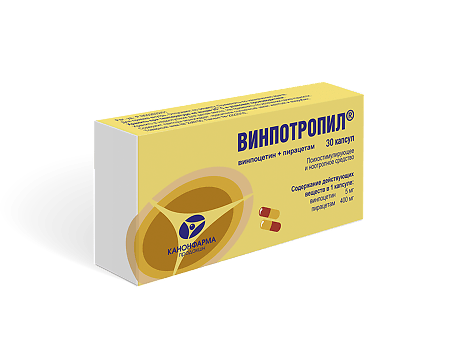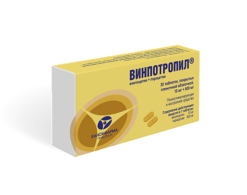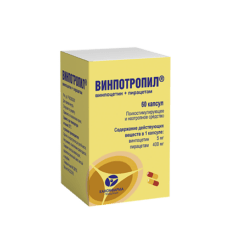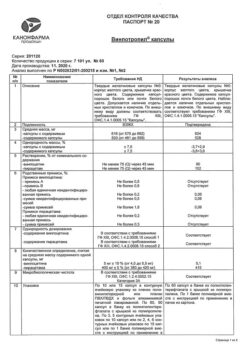No products in the cart.
Vinpotropil, 5 mg+400 mg capsules 30 pcs
€9.69 €8.48
Description
Pharmacodynamics
Vinpotropil is a combined drug. It has properties typical for a brain blood flow enhancer (Vinpocetine) and for a nootropic (Piracetam).
As an agent improving cerebral blood flow:
It improves brain metabolism by increasing glucose and oxygen uptake by brain tissue. Increases resistance of neurons to hypoxia; enhances glucose transport – to the brain, through the blood-brain barrier; shifts the process of glucose breakdown to a more energy-efficient, aerobic pathway; selectively blocks Ca2+-dependent phosphodiesterase; increases levels of adenosine monophosphate (AMP), cyclic guanosine monophosphate (cGMP) and adenosine triphosphate (ATP) of the brain.
It enhances the metabolism of brain noradrenaline and serotonin; stimulates the ascending branch of the noradrenergic system, has an antioxidant effect. Reduces platelet aggregation and increased blood viscosity; increases erythrocyte elasticity and blocks erythrocyte utilization of adenosine; helps increase erythrocyte oxygen output. Increases cerebral blood flow; reduces cerebral vascular resistance without significant changes in systemic blood flow. Does not have the effect of “stealing” and increases blood supply, especially in ischemic areas of the brain. It penetrates through the placental barrier.
As a nootropic:
It has a positive effect on brain metabolic processes, slightly increases the concentration of ATP in the brain, increases the synthesis of ribonucleic acid and phospholipids, stimulates glycolytic processes, increases glucose utilization; it improves integrative activity of the brain, promotes memory consolidation, facilitates learning; it changes the speed of excitation distribution in the brain, improves microcirculation without having a vasodilator effect, inhibits activated platelet aggregation; it has a protective effect in brain injuries caused by hypoxia, intoxication, electric shock; it enhances alpha- and beta-activity, reduces delta-activity in electroencephalogram, reduces severity of vestibular nystagmus; improves connections between cerebral hemispheres and synaptic conduction in neocortical structures, increases mental activity, increases cerebral blood flow; it has no sedative, psychostimulant effect.
The effect is developing gradually.
It has a pronounced effect on the symptoms of initial manifestations of cognitive disorders of cerebral-vascular genesis in elderly and senile patients. It is recommended in psychogeriatric practice.
Pharmacokinetics
Vinpocetine is rapidly absorbed. The time of reaching maximum plasma concentration is 1 hour. Absorption occurs mainly in the proximal parts of the gastrointestinal tract. During passage through the intestinal wall it is not metabolized.
The maximum concentration in tissues is observed 2-4 hours after oral administration. Protein binding is 66%, bioavailability when taken orally is 7%. Clearance is 66.7 l/h, exceeds liver plasma volume (50 l/h), indicating extrahepatic metabolism. The kinetics is linear in repeated administration. Half-life in humans is 4.83±1.29 hours. It is excreted by the kidneys and through the intestine in the ratio of 3:2.
Piracetam after oral administration is well absorbed and penetrates into various organs and tissues. Bioavailability is about 95%. The maximum concentration in blood is reached in 0.5-1.0 hour after oral administration. It penetrates through the blood-brain barrier and accumulates in brain tissue 1-4 hours after oral administration.
It is eliminated from the cerebrospinal fluid much slower than from other tissues. It is practically not biotransformed and is excreted 2/3 of the time unchanged by the kidneys within 30 hours. Half-life from plasma is 4.5 hours, from brain – 7.7 hours.
Indications
Indications
Insufficiency of cerebral circulation (the recovery period of ischemic and hemorrhagic stroke), encephalopathies of various genesis, including alcoholism;
Parkinsonism of vascular genesis, intoxications, brain injuries and other diseases of the central nervous system, accompanied by decreased intellectual and mental functions;
Psycho-organic syndrome with predominant signs of asthenia and adynamy, asthenic syndrome;
./li>
Labyrinthopathies, Meniere’s syndrome;
Prevention of migraine and kinetosis.
Active ingredient
Active ingredient
Composition
Composition
1 capsule contains:
Active substances:
Vinpocetine 5 mg;
Piracetam 400 mg.
Auxiliary substances:
Lactose (milk sugar);
Talc.
Composition of the gelatin capsule body:
Titanium dioxide;
Quinoline yellow dye;
Sunset yellow dye;
Gelatin.
Composition of the gelatin capsule cap:
Titanium dioxide;
Dye azorubin;
Gelatin.
How to take, the dosage
How to take, the dosage
For patients 18 years of age and older: Orally, 1-2 capsules 2-3 times a day before meals.
The last dose is 4 hours before bedtime.
The maintenance dose is 1 capsule 3 times a day.
The duration of the treatment course is from 2-3 weeks to 2-6 months.
The dose of the drug should be gradually reduced before withdrawal.
Interaction
Interaction
Risks: risk of hemorrhagic complications on heparin therapy, the effects of thyroid hormones, antipsychotic drugs (neuroleptics), psychostimulants, indirect anticoagulants, including acenocoumarol (more pronounced decrease in platelet aggregation, fibrinogen, Willebrand factor, plasma and blood viscosity).
Some increase of the hypotensive effect is possible with concomitant use with methyldopa (blood pressure control is necessary).
Weakening: the effect of anticonvulsants (reduces the seizure threshold).
Although there is no data to confirm the possibility of interaction, caution is recommended when prescribing simultaneously with drugs of central, antiarrhythmic action.
Special Instructions
Special Instructions
The presence of prolonged QT interval syndrome and administration of drugs causing prolongation of the QT interval require periodic ECG monitoring. Due to the effect of Piracetam on platelet aggregation, caution is recommended when prescribing the drug in patients with impaired hemostasis, during major surgery or in patients with symptoms of severe bleeding.
Influence on driving and operating machinery
Caution should be exercised when driving and operating machinery during treatment.
Contraindications
Contraindications
Hypersensitivity;
Severe cardiac rhythm disorders;
Ischemic heart disease (severe course);
Acute stage of hemorrhagic stroke;
Renal and/or hepatic failure;
Children under 18 years of age (due to insufficient data).
Patients with rare inherited conditions such as galactose intolerance, lactase deficiency, or glucose-galactose malabsorption should not take Vinpotropil.
Side effects
Side effects
Cardiovascular system disorders:ECG changes (ST-segment depression, Q-T interval prolongation), tachycardia, extrasystole, blood pressure (BP) lability (often decrease).
From the central nervous system (CNS): motor disinhibition, irritability, depression, asthenia, dizziness, headache, sleep disorders (insomnia, increased sleepiness), mental agitation, impaired balance, worsening the course of epilepsy, anxiety, hallucinations, confusion, extrapyramidal disorders, reduced ability to concentrate.
Digestive system disorders:nausea, vomiting, heartburn, diarrhea, abdominal pain, decreased appetite, gastralgia, constipation.
Metabolic side:increased body weight, increased sweating.
Sensory organs: vertigo.
Skin side:dermatitis, pruritus, urticaria, skin hyperemia.
Allergic reactions: hypersensitivity, anaphylactic reactions, angioedema.
Overdose
Overdose
Symptoms: abdominal pain, diarrhea with blood.
Treatment: symptomatic therapy, hemodialysis (effectiveness 50-60%).
Pregnancy use
Pregnancy use
The drug is contraindicated in pregnancy and lactation.
Additional information
| Weight | 0.034 kg |
|---|---|
| Shelf life | 4 years. |
| Conditions of storage | In a dry, light-protected place at a temperature not exceeding 25 °C. |
| Manufacturer | Kanonfarma Production ZAO, Russia |
| Medication form | capsules |
| Brand | Kanonfarma Production ZAO |
Other forms…
Related products
Buy Vinpotropil, 5 mg+400 mg capsules 30 pcs with delivery to USA, UK, Europe and over 120 other countries.

















